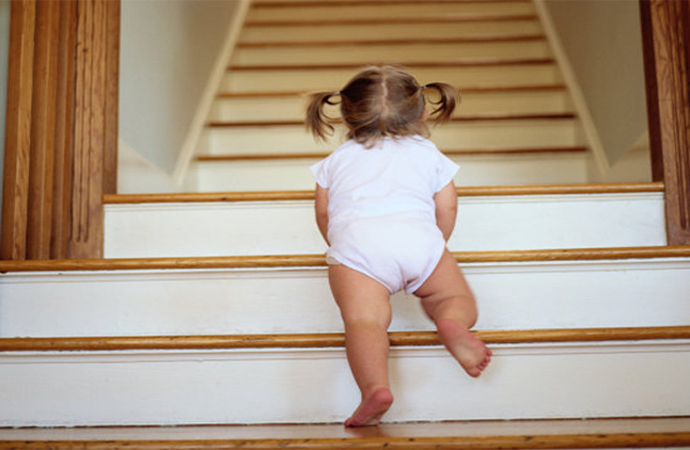Tips to Child Proof Your House
Effective and affordable child-proof items new parents can purchase to keep their child protected as he or she grows and begins exploring different areas of the home.
Welcoming a new child into the world is one the most exciting times in an individual’s life. When families are buying a home to accommodate their growing family, it’s equally important to purchase the right supplies to baby-proof their house. Putting safeguards in place to mitigate potential danger is recommended for children below age four, according to This Old House.
There are a few effective and affordable child-proof items new parents can purchase to keep their child protected as he or she grows and begins exploring different areas of the home.
 Locks
Locks
Several different types of locks exist for cabinets and drawers. Children are naturally curious, and failing to place locks on cabinets within a toddler’s reach can give them access to potentially deadly materials, ranging from hazardous cleaning supplies to heavy objects. It’s easy to overlook the small things, but even a child who is able to get into a parent’s home office can find tiny items like tacks or paper clips that can pose choking hazards. The same is true for drawers, which may hold sharp objects or other tiny tools that could harm a child. Many baby stores or home improvement chains sell a variety of child locks, ranging from simple plastic drawer cuffs to magnetic locks that are placed on the inside of a cabinet and can only be opened with a magnetic key.
Secure furniture

Kids LOVE to climb! Furniture or accent pieces, such as bookcases, dressers and bedroom bureaus, are attractive to children who like to climb. But the risk of an unsecured bookcase or dresser toppling over and pinning a small child is high, so parents can increase their toddler’s safety by anchoring these items to the wall. Other heavy items that have the potential to fall over should be moved to a location where they will not be disturbed.
 Cover cords, outlets
Cover cords, outlets
Covering electrical outlets can lower a child’s risk of electrical shocks that can result from pulling out appliance cords or sticking their fingers in the sockets. Inserting plastic sliding covers over sockets can shield children from harm and hiding cords underneath carpets or behind other objects may prevent toddlers from pulling them out of sockets or chewing on them.
It is also important to know how to react if your child does suffer an electric shock. Baby Center gives great expert advice on how to handle this scary situation.
Get on their level
Once you safety proof your home…think like a kid! Get down on your hands and knees and see how things look from their point of view. What looks like a tempting place to explore? Are there objects that are eye level that pose a threat to their safety? Are there objects on the floor that they could pick up and put in their mouth?
Do you have tips for baby proofing a home? We would love to hear them.





9 Comments
Tips to Child Proof Your House | Susan Lerner's Real Estate Blog
July 8, 2013[…] Kids LOVE to climb! Furniture or accent pieces, such as bookcases, dressers and bedroom bureaus, are attractive to children who like to climb. But the risk of an unsecured bookcase or dresser toppling over and pinning a small child is high, so parents can increase their toddler’s safety by anchoring these items …read more […]
Tips to Child Proof Your House | Elouise Margita's Blog
July 8, 2013[…] Once you safety proof your home…think like a kid! Get down on your hands and knees and see how things look from their point of view. What looks like a tempting place to explore? Are there objects that are eye level that pose a threat to their safety? Are there objects on the floor that they could pick up and put …read more […]
Things to Consider When Baby Proofing Your Home | %_%% | Coldwell Banker Blue Matter
October 2, 2013[…] To learn more about baby proofing click here […]
Things to Consider When Baby Proofing Your Home | Susan Lerner's Real Estate Blog
October 3, 2013[…] To learn more about baby proofing click here […]
Things to Consider When Baby Proofing Your Home | Donna Dagley's Blog
October 3, 2013[…] To learn more about baby proofing click here […]
Things to Consider When Baby Proofing Your Home | Earl Forbes Blog
October 3, 2013[…] To learn more about baby proofing click here […]
Realty Pro | Things to Consider When Baby Proofing Your Home
April 9, 2015[…] To learn more about baby proofing click here […]
Judith Adames
March 17, 2017It true every parent must concern about child proofing house and so do I that’s why i really Appreciate the way you write about child proofing. your idea about covering cords is really worthy.thanks for sharing your words.
Source : goo.gl/u020Z1
Jon Marsiglia
April 20, 2017These are excellent tips for childproofing your home and making it safer for babies and small children. In addition, I would love to add the idea that all parents should become certified in First Aid and CPR. While you can protect your child from some household dangers, accidents happen. And knowing what to do in the case of an emergency is important. Thanks again for sharing. I hope all parents read up on how to baby proof their homes and make things better for curious children.